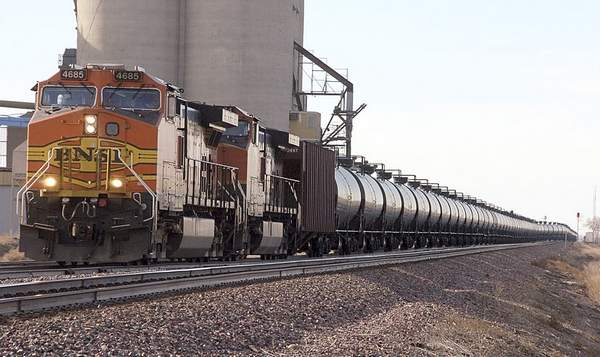forum
library
tutorial
contact

Traffic Jam Slows Railroad Service
by Editorial BoardCapital Press, April 17, 2014
|
the film forum library tutorial contact |

|
Traffic Jam Slows Railroad Serviceby Editorial BoardCapital Press, April 17, 2014 |
As railroads have been pressed into service to carry oil, wheat farmers and other users
say they have been put in the caboose when it comes to serving their needs.
 It's not easy running a railroad. It's even tougher for the many farmers across the West who rely on railroads to get their wheat and other crops to market.
It's not easy running a railroad. It's even tougher for the many farmers across the West who rely on railroads to get their wheat and other crops to market.
Witness the plight of wheat farmers in Montana and across the northern tier of the Lower 48 states. They need prompt and reliable rail service to move their crop to processors or to ports on the West Coast or the Gulf Coast. What some have been getting from the railroads is surcharges and delays.
The reasons for those delays and added expenses can be boiled down to two words: coal and oil.
The coal industry has long been a heavy user of railroads. With major coal deposits in Wyoming and Montana, Western rail traffic has been impacted. Last year alone, the Burlington Northern Santa Fe Railway moved 2.2 million railcars of coal around the West. That makes coal the second largest customer of the railroad after container traffic.
But the oil industry is also having an impact. Oil producers in Alberta, Canada, and North Dakota are in the midst of a huge oil boom, and it has also taxed the capacity of railroads like the BNSF, which handles 49 percent of the rail traffic in the Western U.S.
The amount of crude oil from North Dakota and Canada hauled by rail has grown rapidly in recent years. For BNSF alone, the number of tank cars it has moved in the past two years has increased from about 354,000 in 2012 to 504,321 last year -- about 42 percent. So far in 2014, the railroad had moved 144,584 tank cars as of April 5, up 11.5 percent from the same period last year.
At the same time, the number of grain cars BNSF moved has dropped from a little more than 531,000 in 2012 to 471,476 last year, a decrease of 11.19 percent. This year to date, the number of grain cars is down 10.8 percent.
Keep in mind that BNSF covers 28 states, from the West Coast to Chicago, New Orleans and Atlanta, so only a portion of that traffic can be apportioned to northern and Northwestern states. Railroad spokeswoman Amy Casa said crude oil represents only 4 percent of BNSF's total traffic.
That's why the railroad has set aside $5 billion this year to expand and improve its system, Casa said. About $900 million of that will be spent on the Northern Corridor. That's on top of $7.7 billion spent system-wide in the previous two years.
Another factor is the long-delayed XL pipeline, which would extend from Alberta southward to the U.S. As of the end of 2013, 180,000 barrels of oil a day was being shipped by rail from Alberta to the U.S., mainly to refineries in Texas and elsewhere. That's about 250 rail tanker cars a day leaving Alberta oil fields.
Whether the pipeline will be built is a matter of national politics -- it has been debated for years -- but it could help relieve the traffic jam on U.S. railroads.
In the meantime, it's difficult to see an easy fix for farmers who depend on BNSF and other railroads to ship their crops. Trucks are expensive, and barges can't reach many areas. The best they can hope for is some relief is more rail capacity and construction of a pipeline that will take some of the pressure off the railroads.
learn more on topics covered in the film
see the video
read the script
learn the songs
discussion forum
